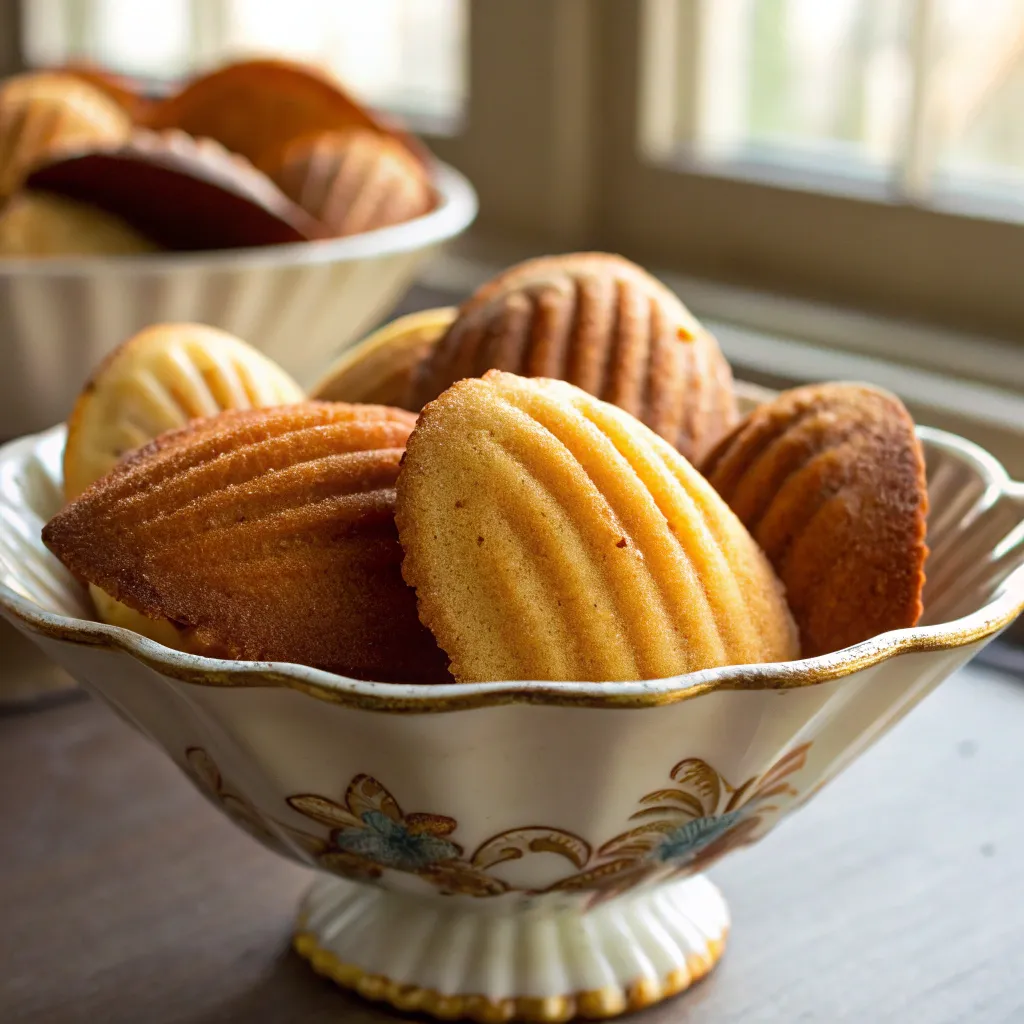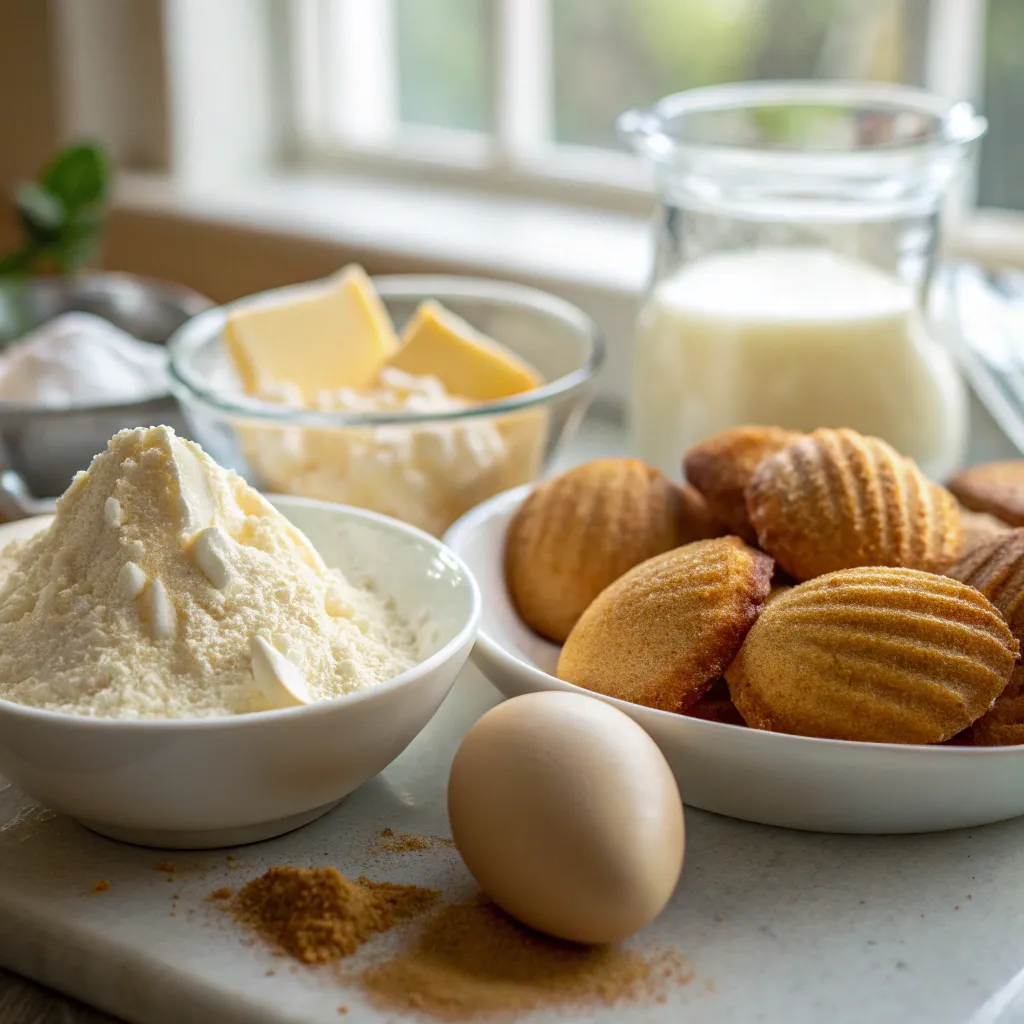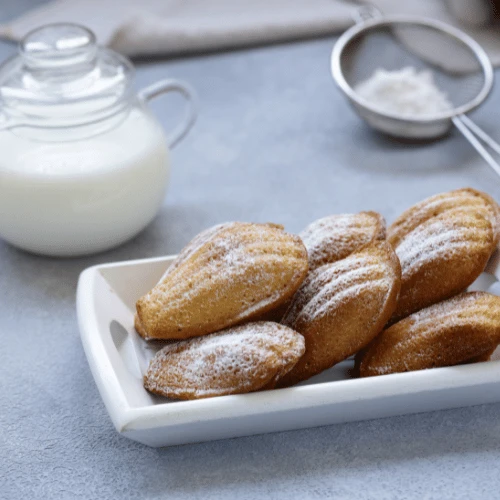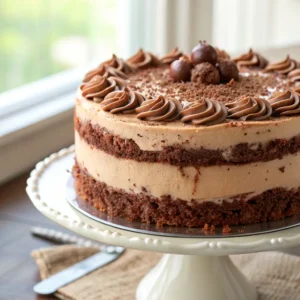Welcome to the Best Madeleine Cookies Recipe Using Cream in 5 Steps. This cookie recipe offers a classic French treat with a soft and buttery texture. Our Madeleine cookie recipe uses heavy cream to lock in moisture and create a moist, flavorful crumb. The simple method emphasizes gently folding dry ingredients into wet ones and then chilling the batter for a perfect rise. You will enjoy a golden brown exterior with a delicate, airy interior. This guide provides clear, step-by-step instructions and essential tips to ensure you achieve bakery-quality madeleines every time you bake. Enjoy every bite of these delightful treats.
table of contents
Key Benefits for Madeleine Cookies Recipe Using Cream

Rich Buttery Flavor
Heavy cream enhances flavor, resulting in a rich, buttery taste. This cookie recipe marries the classic French technique with a modern twist. Butter and cream work together to provide a deep, comforting, and indulgent flavor. These madeleine cookies capture the essence of traditional French pastries in every bite.
Simple, Step-by-Step Process
Our clear instructions simplify a seemingly intricate process. The method guides you through mixing wet and dry ingredients, gently folding the mixture, and chilling the batter. With a prepared madeleine pan and easy-to-follow steps, beginners can achieve bakery-quality results. This straightforward approach makes the recipe accessible to anyone.
Classic French Tradition
Embracing a classic madeleine recipe, this guide honors French baking traditions. It combines time-tested techniques with modern simplicity, ensuring that each cookie turns out with a delicate hump and golden brown edges. Enhanced by cream, the traditional method results in a signature cookie that reflects a rich culinary heritage.
Versatile and Inspiring Creation
This recipe inspires creativity in the kitchen. Beyond the classic version, you can explore variations by dipping cooled madeleines in melted chocolate or adding a touch of vanilla extract. Whether served at a brunch or an intimate gathering, these cookies offer versatility, making them ideal for various occasions and tastes.
Ingredients

Dry Ingredients
• All-Purpose Flour (1 cup): Provides structure to each madeleine. It blends seamlessly with the eggs and sugar for a classic madeleine cookie consistency.
• Baking Powder (1/2 teaspoon): Helps the batter rise, ensuring your madeleines turn out soft and airy.
• Salt (1/4 teaspoon): Enhances the overall flavor, balancing the sweetness in this cookie recipe.
Wet Ingredients
• Eggs (3 large, at room temperature): Essential for creating a light, spongy texture in every madeleine cookie. Their natural binding quality brings the ingredients together harmoniously.
• Granulated Sugar (3/4 cup): Works with the eggs to form a fine, delicate crumb that defines these madeleines.
• Heavy Cream (2 tablespoons, plus extra if desired): A key player in this madeleine cookies recipe using cream, heavy cream enriches the flavor and helps maintain moisture, ensuring the cookies remain soft and buttery.
• Vanilla Extract (1 teaspoon): Adds a subtle, aromatic touch that elevates the overall taste of this classic madeleine recipe.
Finishing Touches
• Melted Unsalted Butter (1/2 cup, cooled): Infuses a rich, buttery quality essential for a perfect madeleine cookie. It binds with the dry ingredients to create that unique crumb.
• Powdered Sugar (1/2 cup, for dusting): Sprinkled on top after baking, it adds a light, sweet finish to your cookies.
• Prepared Madeleine Pan: Critical for shaping these cookies, ensuring the classic hump and beautiful form that makes Madeleines so distinctive.
Each ingredient in this cookie recipe plays a vital role. From the heavy cream that locks in moisture to the melted butter that delivers a rich, buttery taste, every component is selected to help create the best madeleine cookies that are both traditional and innovative.
Instructions

Step 1: Preheat and Prepare the Pan
Begin by preheating your oven to 375°F. Thoroughly butter each mold of your prepared Madeleine pan, then lightly flour them to prevent sticking. This step ensures your madeleine cookies release easily, revealing their classic hump and beautifully defined shape.
Step 2: Mix the Wet Ingredients
Combine eggs, granulated sugar, heavy cream, and vanilla extract in a large mixing bowl. Using a whisk or electric mixer, beat the mixture until it turns light and creamy. This process dissolves the sugar and incorporates air, setting the stage for a soft, buttery texture in your madeleine cookies. Make sure the eggs are at room temperature to achieve the best consistency.
Step 3: Sift and Prepare the Dry Ingredients
In another bowl, combine the all-purpose flour, baking powder, and salt by sifting them together
. Sifting removes any lumps and guarantees even distribution of the dry ingredients. This careful blending is key for maintaining a delicate crumb in your cookie recipe. Once sifted, set the dry ingredients aside until you are ready to combine them with the wet mixture.
Step 4: Combine and Fold Gently
Gradually add the sifted dry ingredients to the wet mixture. Using a spatula, gently fold the ingredients together slowly and deliberately. Avoid overmixing, as this can lead to a dense cookie texture. The goal is to form a smooth, airy batter, highlighting the cream’s role in creating a moist, soft madeleine cookie.
Step 5: Chill, Bake, and Cool
Cover the bowl with plastic wrap and chill the batter in the refrigerator for at least 30 minutes. Chilling the batter allows the flavors to meld and the structure to set, which is crucial for rising evenly in the oven. After chilling, spoon the batter into the prepared Madeleine pan, filling each mold nearly to the top. Bake in the oven for 10 to 12 minutes, until the edges are golden brown and the center springs back lightly when touched. Once baked, let the cookies cool in the pan for a few minutes before transferring them to a wire rack. Lightly dust with powdered sugar while the madeleines are still warm for a touch of extra sweetness.
These detailed steps ensure that every part of the process, from mixing to baking, contributes to making soft, buttery madeleine cookies that are a classic French treat.
Pro Tips and Variations
Perfecting the Batter
When making your madeleine cookies recipe using cream, ensure all ingredients are at room temperature. This step helps the eggs and cream blend smoothly, creating a soft, buttery texture. Always use a spatula to fold the dry ingredients gently into the wet. This technique prevents overmixing, which can cause the cookies to be dense. Taking time to chill the batter is crucial; it allows flavors to settle and the structure to develop properly. A well-chilled batter also helps create the classic hump on each madeleine cookie.
Baking and Cooling Strategies
A prepared Madeleine pan is essential for achieving the perfect shape. Before baking, butter and lightly flour your pan to ensure each cookie releases easily. Monitor your oven temperature carefully. Even a slight fluctuation can affect the cookies’ rise and color. Once baked, let the madeleines cool in the pan for a few minutes. This short cooling period helps them firm up before transferring to a wire rack. Cooling on a rack ensures the cookies remain moist, preventing them from becoming soggy.
Creative Flavor Variations
Experiment with flavor additions to make your recipe stand out. Adding a bit of lemon zest or orange extract to the batter can bring a fresh twist to this classic treat. Try substituting part of the heavy cream with almond milk or a touch of almond extract for a richer flavor. These changes can enhance the natural buttery quality and create unique variations that appeal to different palates. Consider swirling a small amount of melted dark or milk chocolate into the batter before baking. This twist offers an extra layer of flavor that pairs well with the gentle sweetness of the cookies.
Presentation and Storage
For an extra touch, dust the freshly baked madeleines with powdered sugar. This not only adds sweetness but also improves visual appeal. Serve your cookies with tea or coffee to highlight their soft and moist texture. If you plan to store them, use an airtight container at room temperature. This storage method helps the cookies maintain their delicate structure and moisture, ensuring that your classic madeleine treats remain soft and buttery.
These tips and variations can help you customize your cookie recipe, ensuring every batch of Madeleine cookies using cream meets your highest standards. Enjoy the process and explore new flavor combinations to keep your baking experience fresh and rewarding.
Serving Suggestions
Classic Pairings
Madeleine cookies are a versatile treat that pairs wonderfully with various beverages. For a traditional experience, serve these soft, buttery madeleine cookies with freshly brewed tea or coffee. The mild sweetness of the cookies complements the rich, robust flavors of a dark roast or a classic Earl Grey tea. You can also pair them with a light herbal infusion, creating a balanced taste that highlights the cookie recipe’s delicate flavor profile.
Elegant Dessert Presentation
When it comes to presentation, simplicity is key. Arrange the madeleine cookies on a decorative platter or a rustic wooden board. To add a touch of elegance, lightly dust the cookies with powdered sugar before serving. Consider placing a small bowl of whipped cream or a drizzle of melted dark or milk chocolate nearby. These extras enhance the taste and allow guests to customize their experience. For a creative twist, serve the cookies with a lemon curd or berry compote. These additions bring a freshness that contrasts beautifully with the rich, buttery madeleine cookie.
Creative Serving Styles
If you want innovative ways to serve your madeleines, consider stacking them in a pyramid shape on individual dessert plates. Drizzle a light syrup from heavy cream and vanilla extract over the stack to add moisture and extra flavor. Alternatively, you can cut the cookies into halves and layer them with fruit and a dollop of whipped cream to create a deconstructed dessert. This presentation style looks appealing and makes it easier to enjoy every element of the cookie recipe.
Seasonal and Occasion-Based Ideas
Tailor your serving suggestions to match the season or special occasions. In winter, offer your madeleine cookies with warm spiced tea or hot cocoa. Serve them with iced tea or a chilled sparkling beverage during summer gatherings. For festive events, arrange the cookies on a tiered stand and decorate them with a few seasonal garnishes, such as mint leaves or edible flowers. These creative serving ideas help the cookies stand out and add a festive touch to any table setting.
Storage and Enjoyment
Remember that madeleines are best enjoyed fresh. However, if you need to store them, keep the cookies in an airtight container at room temperature. This ensures they remain moist and retain their buttery texture for longer. Enjoying these cookies within a day or two of baking will always deliver the best flavor and texture.
Conclusion
In conclusion, this best Madeleine cookie recipe using cream is a simple yet refined cookie that combines classic French techniques with modern taste. The blend of eggs, heavy cream, and butter creates a soft, buttery texture that sets these madeleine cookies apart. Each step, from preparing the pan to carefully folding the ingredients, helps deliver a moist, golden-brown treat that is a tribute to traditional baking.
The recipe offers clear instructions and helpful tips to ensure a perfect rise and delicate hump. Whether you enjoy them with tea or coffee or serve them at a special gathering, these cookies provide comfort and elegance in every bite. We hope this guide inspires you to create your version of these charming cookies. Embrace the art of French baking with this recipe, and enjoy a timeless treat that brings joy and satisfaction for your pure delight.
FAQs
Below are some frequently asked questions that address common concerns and tips for mastering our best Madeleine cookies recipe using cream. These answers offer practical advice to help you achieve the perfect soft and buttery texture every time you bake.
How to keep madeleines moist?
Keeping madeleines moist relies on proper ingredient temperatures and precise baking times. Ensure eggs and heavy cream are at room temperature before mixing, allowing for a more uniform blend and a lighter batter. Chill the batter for the recommended period to help set the structure and lock in moisture. Avoid overbaking by monitoring the cookies closely; remove them when the edges turn golden brown. Additionally, consider using cake flour as an alternative to all-purpose flour for an even lighter texture and improved moisture retention. Finally, store the madeleines in an airtight container at room temperature, which helps maintain their soft, moist quality for longer periods.
What makes Madeleines so good?
Madeleines are beloved for their unique combination of textures and flavors. The recipe’s blend of eggs, sugar, butter, and heavy cream creates a light, airy crumb with a slightly crisp edge that contrasts beautifully with the tender center. The signature hump is not just a visual delight; it also contributes to a richer taste by creating more surface area that caramelizes slightly during baking. The balance of ingredients results in a delicately sweet and richly buttery cookie. Their versatility allows them to be enjoyed independently or paired with tea or coffee, enhancing any dining experience. This balance of flavor and texture is what makes Madeleines a timeless classic.
What is a substitute for madeleine molds?
Effective alternatives are available if you do not have a traditional Madeleine pan. Silicone muffin molds or mini bundt pans can serve as practical substitutes. These alternatives mimic the distinctive shape and help form a similar hump with a gently crisped edge. When using a substitute mold, ensure you grease and lightly flour it to prevent sticking, just as you would with a classic madeleine pan. Be mindful that the heat distribution may vary slightly, so you might need to adjust the baking time accordingly. While the traditional mold is preferred for authenticity, these options allow you to enjoy your cookie recipe without compromising quality or presentation.
Why are my madeleines dry?
Dry madeleines can be the result of several factors. Overbaking is one of the most common issues; even an extra minute in the oven can lead to moisture loss and a crumbly texture. Accurate ingredient measurements are essential, as too little heavy cream or butter will reduce the recipe’s ability to lock in moisture.
Overmixing the batter can also incorporate too much air, which, while creating a light texture, may lead to a drier end product if not managed correctly. Always follow the recipe closely, and consider checking the cookies a minute before the suggested baking time to ensure they maintain their soft and buttery consistency. Adjustments in mixing and baking techniques can help resolve these issues and yield a perfect batch of madeleines.
Each answer here aims to provide practical insights that empower you to troubleshoot and refine your baking process, ensuring your madeleine cookies remain the best version of this classic French treat.




Coool
thank you malta